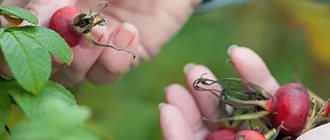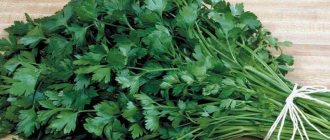How to store radishes in the refrigerator
Fresh radishes don't last very long. But there are ways to significantly extend shelf life, and the best place for storage remains the refrigerator.
How to store radishes in the refrigerator in the vegetable compartment
The easiest way is to place root vegetables on the bottom shelf of the refrigerator in the vegetable compartment. In such conditions, they will not lose their taste for 2 weeks.
Together with the tops, unpeeled radishes will last longer in the refrigerator.
It should be taken into account that different varieties differ in their storage abilities; late root crops remain fresh the longest.
Storing radishes in a plastic bag
Another method suggests pre-washing the vegetables, trimming the tops and shortening the roots. After this, the root vegetables are allowed to dry from moisture, and then they are placed in a plastic bag and put in the refrigerator in the lower compartment.
Since vegetables lose moisture during storage, it is important to prevent them from rotting. To do this, sometimes paper napkins are placed inside the bag, which will absorb condensation, and holes are made for air.
You need to make holes in the bag with radishes to allow air to enter so that moisture does not accumulate inside.
In this case, the shelf life is extended to 3 weeks.
Storing radishes in a jar of water
A good way to extend their shelf life is to refrigerate the radishes in water. Root vegetables need to be washed and cleaned of roots and leaves, and then placed in a glass jar and filled with clean water.
When stored in the refrigerator, water will prevent the radishes from drying out and wilting prematurely.
In a jar of water, the vegetable can last in the refrigerator for 20-40 days. At the same time, you must remember to change the fluid every 3 days.
Freezing instructions
So, let's start harvesting for the winter, and first of all, let's decide what needs to be prepared for work.
Inventory
To store whole fruits in the freezer or on an unglazed balcony, take a thick plastic bag. If the size of the freezer allows, you can take a small wooden or plastic box.
Attention: Several holes must be made in the plastic bag for ventilation, otherwise, even in frozen root vegetables, rot may form and spoil other vegetables.
For chopped radish, thick bags (special for freezing), small plastic containers, and glass jars are also suitable. Portions should be formed into single portions and used in full each time for cooking in winter, since radish does not tolerate several defrostings and freezing.
Preparation for storage
Whole fruits are thoroughly washed under running water and air dried. You don’t have to remove the skin, but thawed radishes are less easy to peel. The tops are not torn off, but cut off with a sharp knife along with the top. It is also advisable to trim the roots. Prepared vegetables are placed in bags or boxes in one layer and placed in the freezer.
Chopped or grated radishes are washed, peeled, crumbled, allowed to drain a little of the juice and placed in containers, compacted tightly. If the preparations are made as salads or vegetable mixtures, then the preparation proceeds according to the selected recipe.
Is it possible to freeze radishes and how to store them in the freezer?
Radishes cannot last longer than a month in the main compartment of the refrigerator. If you want to preserve a vegetable for the whole winter, you can freeze it; if you follow the rules, this will not affect its beneficial properties.
How to freeze radishes after boiling
A popular method suggests combining boiling and drying with freezing for long-term storage. The procedure looks like this:
- the radishes are washed from the remaining soil and the roots and tops are cut off;
- The root vegetable is cut into slices and boiled for 15 minutes in salted water;
- the circles are removed from the water and sent to dry in the oven on a baking sheet for 20 minutes;
- The dried pieces are put into a bag and placed in the freezer.
If you pre-treat radishes in water and dry them, this will extend the shelf life.
The method looks quite labor-intensive, but the vegetable can be stored for up to 4 months when used.
Storing whole radishes in the freezer
You can freeze root vegetables whole for the winter, although they may become less tasty after thawing. Vegetables collected from the garden are shaken off the ground, rinsed in water and allowed to dry a little. There is no need to cut off the greens and roots. The root vegetables are then placed in a moistened plastic bag and placed in the freezer.
To freeze radishes whole, you need to choose medium-sized root vegetables without damage
Frozen fruits can stay in the freezer for more than 3 months.
Storing grated radishes in the freezer
When frozen whole, vegetables often become too dry and tough. To avoid this, you can pre-chop the radishes. The algorithm looks like this:
- root vegetables are sorted, leaving the strongest and healthiest, and washed in water;
- Tops, roots and spots on the skin are cut off from vegetables;
- radishes are cut into small circles, strips or simply grated on a coarse grater;
- The workpiece is placed in a plastic bag and sent to the freezer.
After defrosting, pre-cut radishes will taste better than whole radishes. Attention! It is best to freeze root vegetables in 2 stages. First, they need to be placed in a chamber with a temperature below - 18 ° C for 15 minutes, and then immediately transferred to the conditions of a regular freezer.
What can you cook from frozen fruits?
We harvest root vegetables so that during the cold season we have the opportunity to touch the summer. It is freezing that helps us prepare dishes that we are used to eating from fresh vegetables. The uses of frozen radishes are varied. Here are some ideas for dishes using frozen radishes (and here you can read our selection of recipes with fresh vegetables):
- Preparation for okroshka . If you want to enjoy cold soup in winter (why not?), use a vegetable mix. Radishes will come in handy. For such a dish, it is better to freeze it in a chopped version with other vegetables and herbs. We cut the root vegetables into strips or grate them if you like finely chopped ingredients in okroshka. After defrosting, add the rest of the products, pour kvass or kefir. Summer soup in winter is ready.
- pancakes from frozen radishes . Not the most common method, but it's good to try for a change. You will also need chopped root vegetables. They are added to semolina, mixed with egg, flour and herbs. Salt to taste, mix, bake. Unusual and tasty.
- Radishes can be added to soup . We chop the vegetable; some fruits can be set aside to decorate the dish later. Fry the onions with flour. Add the grated radish to the water, and add the onion from the frying pan. A few minutes before readiness, add finely chopped herbs - parsley, dill, cilantro, basil. What exactly to use from this depends on your preferences. The result is a low-calorie and healthy dietary soup that cleanses the intestines well.
- Radishes are added to salads . This can be a regular mix of chopped garden vegetables and herbs. Season it with vegetable oil. You can also make a salad with seaweed, radishes and green peas.
- Frozen fruits make a good filling for pies . Some say radishes in pita bread. To do this, you need to take cottage cheese, radishes, cucumber and Armenian lavash. Grind the vegetables, mix with cottage cheese, grease the lavash with sour cream. Wrap the resulting mixture inside. This is a recipe for a delicious and satisfying dish.
Radish dishes will delight you in winter.
Radishes are often used to adhere to the principles of a healthy diet and restore the body.
How to store radishes in the basement
In a country house, radishes can be stored in a cellar or basement for the winter. If the room temperature does not exceed + 1 °C, and the humidity level is 85% or higher, root vegetables will remain calm for several months without losing their taste properties.
Storing radishes in boxes with sand
Lightly moistened sand helps to provide the vegetables with the necessary conditions; if desired, you can replace it with fresh peat. Sand or peat is poured into spacious wooden boxes, radishes are placed, and root vegetables are sprinkled with dry chalk or ash on top.
Sand or peat helps maintain optimal moisture levels for radishes
There is no need to wash or peel vegetables before storing them. They are put into boxes immediately after being removed from the garden.
Storing radishes in the basement on racks
If you don’t have boxes at hand, you can put the radishes on racks or shelves in a cold basement. To prevent vegetables from spoiling, they also need to be sprinkled with wet sand with the addition of chalk in a ratio of 50 to 1.
You can place radishes in the basement directly on wooden shelves or racks
In addition to sand, you can use sawdust; they also retain moisture well.
Storing radishes in the basement in plastic bags
Another method suggests storing vegetables in the basement in large plastic bags with a capacity of about 50 liters. They are tightly stuffed with radishes and placed on the floor in an upright position.
Storage in bags in the cellar extends the shelf life of radishes to 4 months
There is no need to tie the bags tightly; air should still flow to the root crops.
How long do radishes last?
In order for ripe radishes to be stored for a long time (until February), the following recommendations must be followed:
- For storage, you need to have a cellar where there will be sufficient humidity and air temperature.
- The correct variety of radish is selected that is resistant to long-term storage in cellars and basements.
- For storage, prepare a regular box where sand or sawdust is placed.
- The radishes are peeled from the tops, while small tails are preserved (there is no need to wash the fruits).
- The sand or sawdust used is moistened and then poured into the bottom of the box.
- Then the radish roots are laid.
- Afterwards sand (sawdust) and radishes are poured in layers.
For long-term storage, it is necessary to leave the last layer sandy.
Here, special attention is paid to the selection of fruits that can lie for a long time, while having a late ripening period. Under the conditions present in the cellar, the workpiece is stored from several months to six months
How to Store Radishes at Room Temperature
In room conditions, radishes are stored rather poorly and quickly dry out or begin to rot. But sometimes it’s simply not possible to put it away in the cold.
How to Keep Radishes Fresh in the Pantry
The condition of radishes depends greatly on temperature and humidity levels. If the vegetable cannot be put in the refrigerator, you need to find the coolest possible place for it in an apartment with low humidity. Usually such a place becomes a dark pantry; sometimes the radishes are put away on the mezzanine or in closed drawers of the kitchen cabinet.
When storing radishes indoors, it is important to place them away from heat sources and light.
Important! When stored indoors, radishes with tops and roots remain fresh for an average of 5 days. If the greens and roots have already been cut, the time is noticeably reduced; after 12 hours the vegetable will become tough and tasteless.
Storing radishes in marinade
Pickled radishes are suitable for indoor storage. A very simple recipe suggests:
- prepare a marinade from 1 glass of water and 1 glass of vinegar, a small spoon of salt and half a glass of sugar;
- wash and cut the radishes into slices;
- put it in a jar and fill it with the prepared mixture;
- Sterilize and securely roll up the lid.
Pickled radishes retain maximum beneficial properties.
It is believed that it is best to store pickled vegetables in the refrigerator, but this is not a necessary condition. If the jars are sealed hermetically, then it is enough to put the preparations in a dark place with a temperature no higher than 20 ° C, and the pickled radishes will stand quietly for 2-3 months of winter.
Storing Radishes in Oil and Vinegar
You can preserve radishes without refrigeration using vinegar, vegetable oil and dill. To do this you need:
- wash and dry root vegetables and dill;
- cut root vegetables, chop greens and mix in one bowl;
- heat 250 ml of vegetable oil to a boil and cool;
- Boil 2 finely chopped hot peppers in salted water for 10 minutes;
- pour half a glass of table vinegar into slightly cooled water with pepper;
- pour cooled oil into sterile jars, add herbs, radishes and marinade;
- roll up tightly.
Oil and vinegar serve as natural preservatives for radishes and extend shelf life.
As in the previous case, if completely sealed, canned fresh radishes can be stored for a long time. At room temperature in a dark place, it retains its taste and benefits for up to 3 months.
Preparation
Proper preparation of fruits is the key to successful freezing:
Note . In some recipes, radishes are not cut into slices, but grated. Many housewives freeze radishes whole. It all depends on the specific method and your preferences.
Dry storage of radishes
If you need to save radishes for the whole winter, but there is no way to freeze them, you can dry the vegetable. The lack of moisture in the pulp significantly extends the shelf life of radishes, and the taste does not disappear.
How to dry radishes in an electric dryer
The easiest way to prepare dried vegetables is to use a special dryer.
Necessary:
- choose healthy whole root vegetables;
- wash them, dry them with paper towels and cut them thinly;
- spread in an even layer on the trays of the electrical appliance and set the temperature to about 50 °C.
The electric dryer is suitable for any vegetables, including radishes.
During the drying process, the slices are periodically turned over. In total, processing takes about 3-4 hours. You can store dry slices in a paper bag in a dark cabinet in the kitchen for six months.
How to dry radishes in the oven
If you don’t have an electric dryer, you can use the stove oven. This is less convenient, but produces a similar result:
- The oven is heated to 50-60 °C. To prevent the temperature from getting too high, leave the door ajar.
- The washed and chopped root vegetables are laid out on a baking sheet and placed in the oven for about 6-8 hours. Every half hour the slices need to be turned over so that drying occurs evenly.
- At the end of drying, you can close the oven door briefly - this will help evaporate any remaining moisture from the vegetables, but will not cause the radishes to burn.
Drying radishes in the oven takes a lot of time, but allows you to rid the pulp of moisture
. The dried root vegetables are allowed to cool and then stored in paper bags in a dark place. You can use dried vegetables for food for up to six months.
How to make dry radish chips
Dried vegetable slices are most often added to soups and main courses. But you can also use them to make an independent product - chips, which are very popular, particularly in Japan. The chips are made like this:
- washed radishes are cut into thin circles no more than 5 mm thick;
- process for a minute in boiling salted water;
- place the workpiece on a wire rack and dry it;
- Place on a baking sheet in the oven and dry for several hours at 60 °C.
If desired, you can sprinkle the radish chips with salt and spices before putting them in the oven.
Once ready, the product is placed in glass jars and stored in a dry and dark place for 4-6 months.
Which radish is suitable for winter preparations?
For preservation, large fruits with a diameter of 2.5 cm, covered with thin skin are usually used. The color of root vegetables can be different: pink, white, red, purple. They also differ in shape: from flat-rounded to spindle-shaped. The standard option is the variety Anabel F1, Zlata, Champion, Politez, Molniya F1.
To preserve vegetables for the winter, it is better to choose varieties with a medium or late ripening period. They are more tasty and last longer. These include the variety Red Giant, Zlata, Cherriet. The choice of variety also depends on the characteristics of the recipe.
If it is necessary to harvest whole root crops, you should choose varieties with an even, regular shape. If you need to chop a vegetable, preference is given to large-sized fruits with juicy pulp.
Proper harvesting affects the quality of fruits
It is important to remove the green leaves within five hours of digging. Otherwise the pulp becomes watery
Fruit preparation
Remove leaves and stems from root vegetables and rinse several times with running water. Gently remove dried dirt using a dishwashing sponge. If the root vegetables are limp and soft to the touch, it is recommended to soak them in cold water for one hour.











